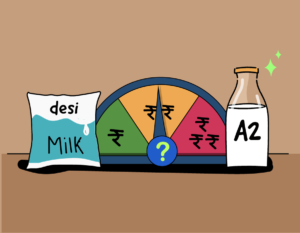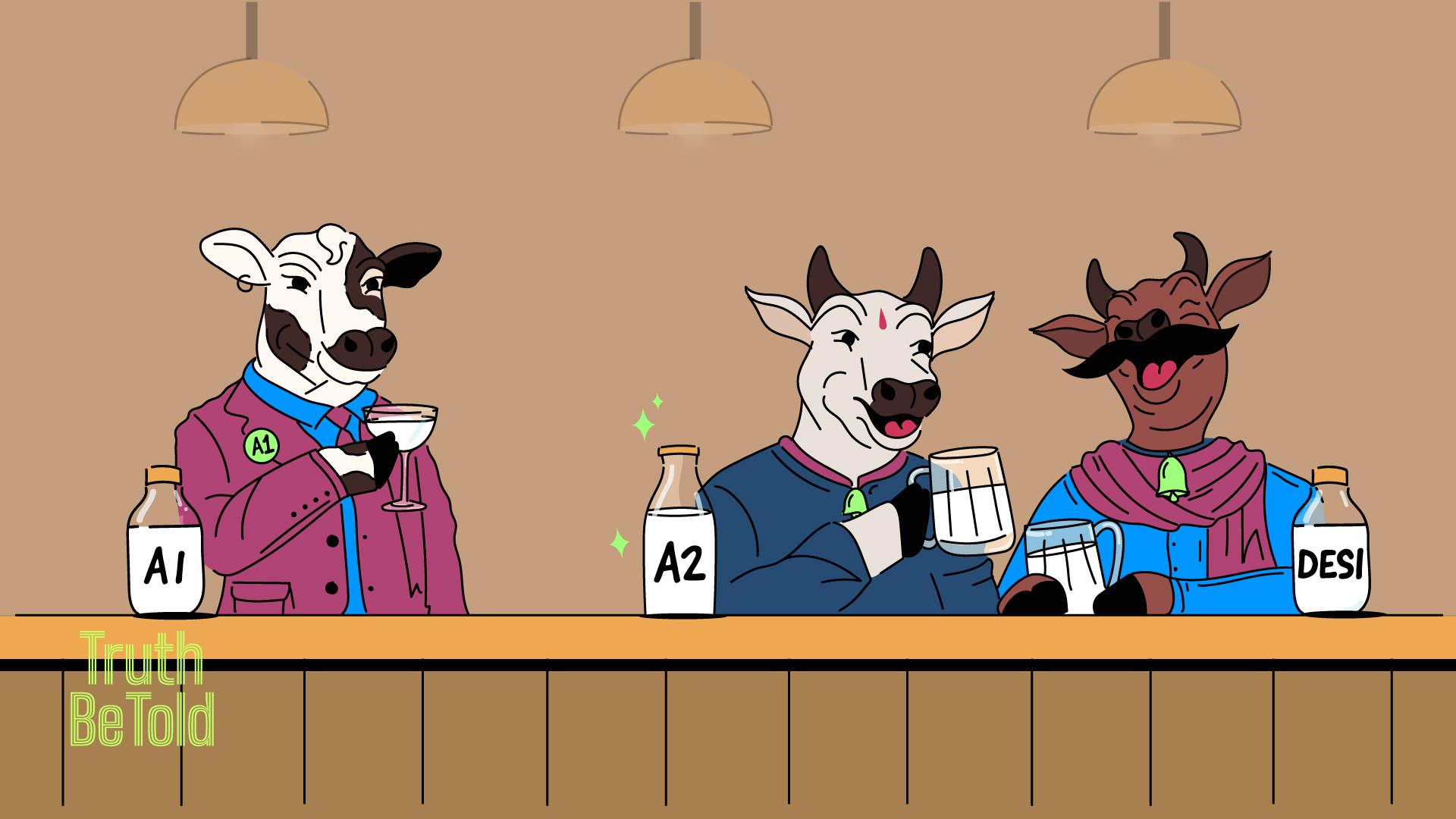Is A2 milk a cash-cow?
The most trustworthy source of food and
fitness journalism in the country.
Editor’s note: A2 milk has gained popularity as an alternative to traditional cow’s milk. Some claim that A2 milk is easier to digest and less likely to cause discomfort than regular milk, while others remain sceptical. In this piece, Shirin Mehrotra, an independent food writer and researcher, provides context for this ongoing debate.
It’s hard to determine if A2 milk is truly healthier as research on the subject remains inconclusive. However, understanding the history behind these claims and placing them within the Indian context can assist you in making informed decisions for yourself, which is the objective of this article.
If you’re a regular consumer of A2 milk and have any thoughts, we’d love to learn from your experience. Please share them with us.
When it comes to food trends, I’m usually not the one to jump on the bandwagon. But a few years ago, I found myself caught up in the buzz around A2 milk.
Suddenly, it seemed like every dairy in India was home-delivering this supposedly healthier, more nutritious, and tastier milk. As a non-milk drinker — except for taking it in my tea or an occasional milkshake — I was sceptical, but I couldn’t resist the allure of a pretty milk bottle delivered right to my doorstep twice a week.
For close to a year, I consumed A2 milk in my tea, made banana shakes with it once in a while and used the excess milk to make dahi, all the while not knowing exactly why I was doing it. The taste of the milk didn’t seem any different to me, and I couldn’t say much about the health benefits.
The only satisfaction I got was consuming milk from “happy cows”, as claimed by the milk supplier. The unethical and violent practices of the dairy industry are known to everyone, so this seemed like a fair way to pacify the “conscious consumer” within me.
But what is the truth? Is A2 really healthier, or is it just another marketing gimmick?
Let’s figure it out.

I want to be clear: the idea of this piece is not to provide a definitive answer to that question. It’s about understanding the debate surrounding A2 milk in India, so you make an informed decision for yourself.
Milk is a great source of protein, containing two major types: casein and whey. Casein is the most abundant protein, with several subtypes including beta-casein, which accounts for about a third of the total protein in milk. Beta-casein comes in two variations: A1 and A2.
Before a genetic mutation occurred in Europe about 5,000 to 8,000 years ago, cows only produced A2 beta-casein in their milk, which is similar to human breast milk protein.
However, selective breeding of cows over time led to a decline in A2 protein and an increase in A1 protein, thanks to the mutation. As a result, milk from certain breeds, such as Holstein, now contains an even split of A1 and A2 proteins.
To meet the demand for milk containing only A2 protein, some farmers selectively breed cows to produce this type of milk. This milk is marketed as “A2 milk”, which only contains A2 beta-casein.
In short, while regular milk contains both A1 and A2 beta-casein, A2 milk only contains A2 beta-casein. (India’s case is a little different. More on that in a bit.)
So why all the fuss over A2 milk?
It all started with research in 1993 by two scientists from New Zealand, Professor Bob Elliott and Dr Corran McLachlan.
They discovered that the A1 protein in milk could cause digestive disorders and even more severe health problems like Type 1 diabetes and heart disease. They also did comparative research and found that milk containing the A2 type protein did not have these harmful side effects and could be better for your health, even if you’re lactose intolerant.
So just to be clear: the primary claim is not that A2 is amazing but that A1 is problematic.
Fast forward a few years, one of the researchers, McLachlan, teamed up with billionaire farmer and entrepreneur Howard Paterson to start the A2 Milk Company (A2MC) in 2000.
Initially, A2MC only licensed the intellectual property for determining the type of protein in cow’s milk, but in 2007, they began producing and selling A2 milk as a replacement for the A1 milk available in stores in Australia and New Zealand.
Despite the promising research and growing popularity of A2 milk, many people remain sceptical, especially since most of the studies supporting its benefits were commissioned by A2MC itself. More studies have been conducted, but the results are not conclusive.

In 2009, Professor Keith Woodford of Lincoln University in New Zealand published a book called “Devil in the Milk” which examined the link between A1 protein in milk and various health issues like Type 1 diabetes, heart disease, autism and schizophrenia.
The book concluded by finding the evidence compelling and that “we should switch to A2 milk”.
While the book was considered groundbreaking, Woodford later appeared to have stakes in A2MC, leading some to question whether the whole A2 milk phenomenon is just a money grab — conflict of interest, yet again.
So point being: the jury is still out on whether A2-only milk is really beneficial than the milk with both A1 and A2.
Let’s hope the scientific community can milk this issue for all its worth and churn out some solid evidence soon. At this point, we just don’t know for sure.
Like what you see so far?
Get TBT articles in your inbox every Saturday
Is the debate relevant in India?
While the controversy around A2 milk continues in the western world, let’s turn the gaze homeward. The scene here is different.
In India, dairy has been a dietary staple for centuries. Thanks to Operation Flood, launched in 1970 by Dr Verghese Kurien and the National Dairy Development Board, India went from a dairy-deficient country to the world’s largest milk producer within 30 years.
This “white revolution” also helped dairy farmers control their resources and direct their development. A national milk grid now links dairy farmers with consumers nationwide to ensure availability.
Now how does it all connect to the A2 milk debate?
Well, it turns out that many indigenous cow species in India, like the Gir, Sahiwal, and Tharparkar, produce milk that contains only A2 protein.
But during Operation Flood, some European breeds of cows that produce A1 milk, like Jersey and Holstein Friesian, were brought in to crossbreed with native cows and create a new species.
However, this crossbreeding only makes up a small fraction of India’s milk production. The majority of the milk still comes from native cows or buffaloes, which produce A2-only milk.
Look at the data.
One: According to Dr Ram Pratim Deka, Senior Research Management Coordinator at the International Livestock Research Institute (ILRI) in India, approximately 45% of the total milk production in India comes from Indigenous breed/nondescript buffaloes (the milk produced by buffaloes also contains A2 beta-casein), 20% comes from Indigenous breed/nondescript cows, 28% by crossbred cows, 3% by exotic cows and another 3% by goats.
Two: A recent genotype study conducted by the National Bureau of Animal Genetic Resources (NBAGR) on approximately 22 desi breeds confirms that native cattle in India are predominantly A2A2 genotypes.
Though it’s hard to exactly quantify, these two studies suggest that the majority of the milk in India is A2-only, meaning the A1 and A2 debate has little significance in India — because the regular milk is mostly A2 only.
It’s just that some are adding the label and charging a premium.
Like what you see so far?
Get TBT articles in your inbox every Saturday
What I do
One: As someone who doesn’t consume more than a cup of milk per day, that too added to chai, it made economic sense for me to switch back to regular milk — that is, the one which does not come with the “A2” label because hey, even regular milk is A2 only.
So why should I pay the premium? Regular cow milk costs Rs 50-60 per litre, while A2 milk starts from Rs 90.

Two: Currently, I consume milk from a brand that promises me fresh milk straight from the farm, produced by desi cows — an additional benefit. Of course, it costs me Rs 84 per litre, but then that’s the price I pay for convenience and taste that’s slightly better than the more popular brands.
Three: Some brands may claim that their milk comes from happy, organic grass-fed cows, taken only once the calf has had its fill — to which I’d say: don’t believe unless you witness it first-hand.
Hope this gives you enough context to understand the debate around “A2 milk” to make an informed decision.
Click on this to sign up for the truth


